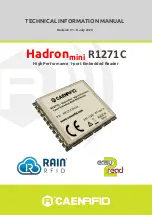
- Hadron
mini
Technical Information Manual
14
The NRST pin is pulled high (3.3 V) by an internal 10 kΩ nominal resistor. To reset the part, drive the pin
strong low for at least the minimum reset pulse width as specified in §
paragraph page 20 (approximately 25 μs). This pin may be driven active low to reset the part,
but should not be driven strong high. Driving the pin strong high prevents the Hadron
mini
R1271C from
resetting itself in case user requested software reset. This pin should be driven using an “open drain drives
low” drive mode, which creates either a strong low voltage or a floating voltage output. If the host device
has a pull-up drive mode, or a series resistor is used with a strong drive mode, the resistor value should be
selected such that the NRST voltage is above 2 V. This arrangement is shown in
page 14, and the resistor size requirement is shown in Equation:
Warning
: Voltages outside of the maximum IO operating voltage range of -0.3 to 4.0 V should
not be applied to the NRST pin. This can cause permanent damage to the device.
Fig. 3.2: NRST Pin Circuit Diagram
Health and Status Pins
The Hadron
mini
R1271C has two pins that indicate the state of the device through their voltages: HEALTH
(pin 22) and STATUS (pin 21). Their behavior is further defined in the debugging section of the IRI SDK user
documentation.
Both pins are outputs operating at a logical voltage level of 3.3 V, and can sink and source 8 mA each. If the
load on one of these pins draws more than the 8 mA sink and source current, the pin is not guaranteed to
meet the VOH and VOL specs listed in the §
Device Input and Output Specifications
Warning
: Excessive current sunk or sourced on the pins can also cause electrical damage to the
device.





























